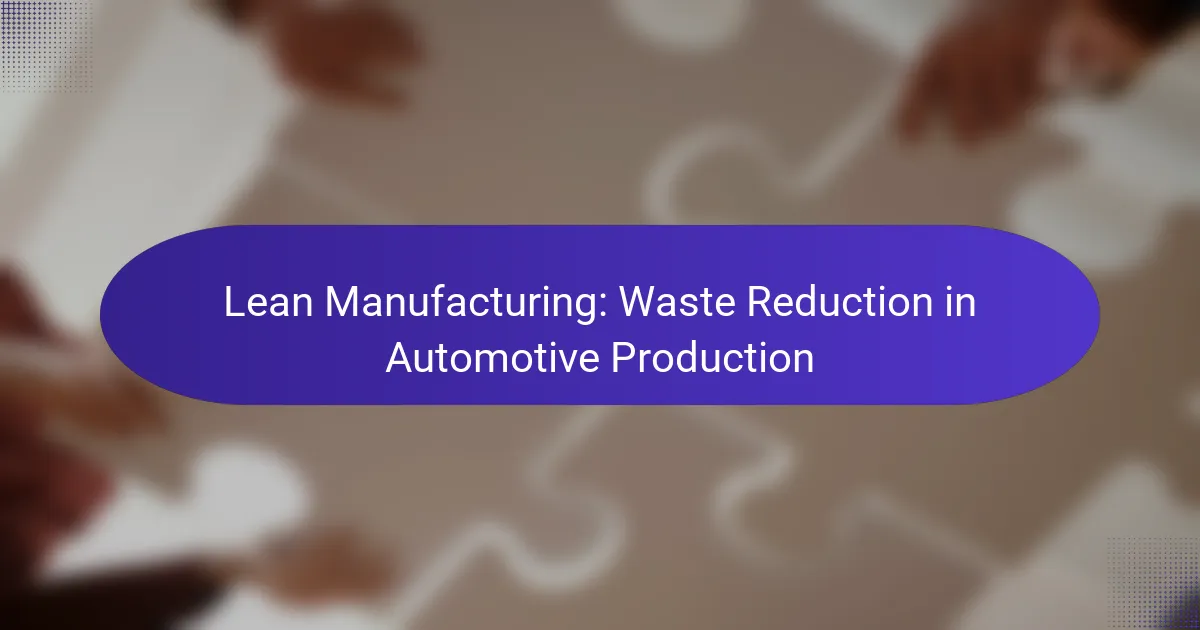Lean tools play a crucial role in enhancing efficiency within textile manufacturing by focusing on waste reduction and process optimization. By implementing methodologies such as Kanban systems and standardized work procedures, manufacturers can streamline operations, improve quality, and lower costs, ultimately leading to increased productivity and profitability.

How can Lean Tools improve textile manufacturing efficiency?
Lean tools enhance efficiency in textile manufacturing by minimizing waste and optimizing processes. These methodologies focus on streamlining operations, improving quality, and reducing costs, which can significantly boost productivity and profitability.
Value stream mapping
Value stream mapping (VSM) is a visual tool that helps identify and analyze the flow of materials and information in textile manufacturing. By mapping out each step in the production process, manufacturers can pinpoint inefficiencies and areas for improvement.
To implement VSM, start by selecting a product family and mapping the current state of the production process. Identify value-added and non-value-added activities, then develop a future state map that outlines improvements. This approach can lead to reduced lead times and lower operational costs.
5S methodology
The 5S methodology focuses on workplace organization and standardization to enhance efficiency. The five steps—Sort, Set in order, Shine, Standardize, and Sustain—help create a clean and organized environment, which is crucial in textile manufacturing.
Implementing 5S involves regularly evaluating the workspace and ensuring that tools and materials are easily accessible. This practice can lead to improved safety, reduced waste, and enhanced productivity, as employees spend less time searching for items and more time on value-added tasks.
Kaizen events
Kaizen events are focused improvement initiatives that engage employees in identifying and solving problems within the manufacturing process. These short, intensive workshops encourage collaboration and innovation, leading to immediate improvements in efficiency.
To conduct a Kaizen event, assemble a cross-functional team and define a specific problem to address. Use brainstorming sessions and root cause analysis to develop actionable solutions. Regularly scheduled Kaizen events can foster a culture of continuous improvement in textile manufacturing.
Just-in-time production
Just-in-time (JIT) production is a strategy that aims to reduce inventory costs by producing only what is needed, when it is needed. This approach minimizes waste and ensures that resources are used efficiently in textile manufacturing.
To implement JIT, establish strong relationships with suppliers to ensure timely delivery of materials. Monitor production schedules closely to align manufacturing with customer demand. This method can lead to lower holding costs and improved cash flow, but requires careful planning and coordination.
Continuous flow manufacturing
Continuous flow manufacturing is a production strategy that emphasizes a smooth, uninterrupted flow of materials through the manufacturing process. This approach reduces cycle times and enhances efficiency in textile production.
To achieve continuous flow, design the layout of the manufacturing floor to minimize movement and delays. Implement standardized work processes and use automation where appropriate. This method can significantly reduce lead times and increase throughput, making it essential for high-volume textile operations.

What are the benefits of implementing Lean Tools in textile manufacturing?
Implementing Lean Tools in textile manufacturing leads to significant improvements in efficiency, quality, and cost-effectiveness. These methodologies focus on minimizing waste and optimizing processes, which can enhance overall operational performance.
Reduced waste
Lean Tools help identify and eliminate various forms of waste in textile manufacturing, such as excess inventory, overproduction, and defects. By streamlining processes, manufacturers can reduce material waste and improve resource utilization.
For example, employing techniques like Value Stream Mapping can highlight areas where resources are underutilized, allowing companies to make informed adjustments. This not only conserves materials but also minimizes the environmental impact of production.
Improved quality control
Quality control is enhanced through Lean Tools by establishing standardized processes and continuous monitoring. Techniques such as Six Sigma focus on reducing variability, which leads to fewer defects and higher product quality.
In practice, implementing regular quality checks at various stages of production can catch issues early, preventing costly rework. This proactive approach fosters a culture of quality throughout the manufacturing process.
Enhanced productivity
Lean Tools boost productivity by streamlining workflows and reducing bottlenecks. Techniques like Just-In-Time (JIT) inventory management ensure that materials arrive exactly when needed, minimizing downtime and maximizing output.
For instance, reorganizing the factory layout to facilitate smoother movement of materials can significantly enhance operational efficiency. This results in faster turnaround times and the ability to meet customer demands more effectively.
Cost savings
Implementing Lean Tools can lead to substantial cost savings in textile manufacturing by reducing waste and improving efficiency. Lower material costs and minimized labor expenses contribute to a healthier bottom line.
Companies can also benefit from reduced overhead by optimizing resource allocation and decreasing the need for excess inventory. These savings can be reinvested into innovation or passed on to customers, enhancing competitive advantage.

Which Lean Tools are most effective for textile manufacturers?
Effective lean tools for textile manufacturers include Kanban systems, root cause analysis, and standardized work procedures. These tools help streamline production processes, reduce waste, and enhance overall efficiency in textile operations.
Kanban systems
Kanban systems are visual management tools that help control the flow of materials and work in progress. By using cards or signals to indicate when to produce or replenish items, textile manufacturers can maintain optimal inventory levels and reduce lead times.
Implementing a Kanban system requires careful planning, including determining the right number of Kanban cards and establishing clear rules for their use. For example, a manufacturer might set a limit of 10 cards for a specific fabric type, ensuring that production only occurs when inventory drops below a certain threshold.
Root cause analysis
Root cause analysis (RCA) is a method used to identify the underlying causes of problems in the manufacturing process. By focusing on the root causes rather than symptoms, textile manufacturers can implement effective solutions that prevent recurrence.
Common RCA techniques include the “5 Whys” and fishbone diagrams. For instance, if a machine frequently breaks down, asking “why” multiple times can lead to discovering that inadequate maintenance is the root cause, prompting a shift to a more rigorous maintenance schedule.
Standardized work procedures
Standardized work procedures are documented processes that outline the best practices for performing tasks in textile manufacturing. These procedures ensure consistency, quality, and efficiency across operations.
To create effective standardized work procedures, manufacturers should involve employees in the documentation process and regularly review and update the procedures based on feedback and performance metrics. For example, a standardized sewing procedure might specify the exact thread tension and stitch length to be used, reducing variability and errors in production.

What are the prerequisites for adopting Lean Tools in textile manufacturing?
To successfully adopt Lean Tools in textile manufacturing, organizations need a solid foundation that includes management commitment, employee training, and clear goals and metrics. These prerequisites ensure that the implementation of Lean principles is effective and sustainable.
Management commitment
Management commitment is crucial for the successful adoption of Lean Tools. Leaders must not only endorse Lean initiatives but also actively participate in the process, demonstrating their dedication through resource allocation and support. This involvement fosters a culture that values continuous improvement.
For instance, management should regularly communicate the importance of Lean practices and how they align with the company’s overall objectives. This can be achieved through meetings, workshops, and visible participation in Lean activities.
Employee training
Employee training is essential for equipping staff with the skills needed to implement Lean Tools effectively. Training programs should cover Lean principles, problem-solving techniques, and specific tools such as value stream mapping and 5S. Engaging employees in hands-on training can enhance their understanding and retention of these concepts.
Consider offering ongoing training sessions and workshops to keep employees updated on Lean practices. This not only improves their skills but also reinforces the organization’s commitment to Lean methodologies.
Clear goals and metrics
Establishing clear goals and metrics is vital for measuring the success of Lean Tool implementation. Goals should be specific, measurable, achievable, relevant, and time-bound (SMART) to provide a clear direction for improvement efforts. Metrics can include production efficiency, waste reduction, and lead times.
Regularly reviewing these goals and metrics allows organizations to track progress and make necessary adjustments. For example, setting a target to reduce lead times by 20% within six months can provide a tangible benchmark for success.

How do Lean Tools compare to traditional manufacturing methods?
Lean tools focus on maximizing efficiency and minimizing waste, contrasting with traditional manufacturing methods that often emphasize output volume without considering resource optimization. By streamlining processes, lean methodologies can lead to improved productivity and reduced operational costs.
Efficiency differences
Lean tools prioritize continuous improvement and value stream mapping, which helps identify and eliminate non-value-added activities. In contrast, traditional methods may rely on fixed processes that can lead to inefficiencies and bottlenecks. For example, a lean approach might reduce production cycle times from several hours to low tens of minutes by optimizing workflows.
Implementing techniques such as Just-In-Time (JIT) inventory management can further enhance efficiency by ensuring materials arrive only as needed, reducing storage costs and waste. This stands in stark contrast to traditional methods that often maintain large inventories, increasing overhead and risk of obsolescence.
Cost implications
Adopting lean tools can significantly lower costs by minimizing waste and improving resource utilization. For instance, companies may see reductions in labor costs by streamlining tasks and enhancing worker productivity. Traditional manufacturing, on the other hand, often incurs higher costs due to excess inventory and inefficient processes.
While initial investments in lean training and tools may be necessary, the long-term savings typically outweigh these costs. Businesses can expect to see a return on investment through lower operational expenses and increased profitability, making lean practices financially attractive compared to traditional methods.



